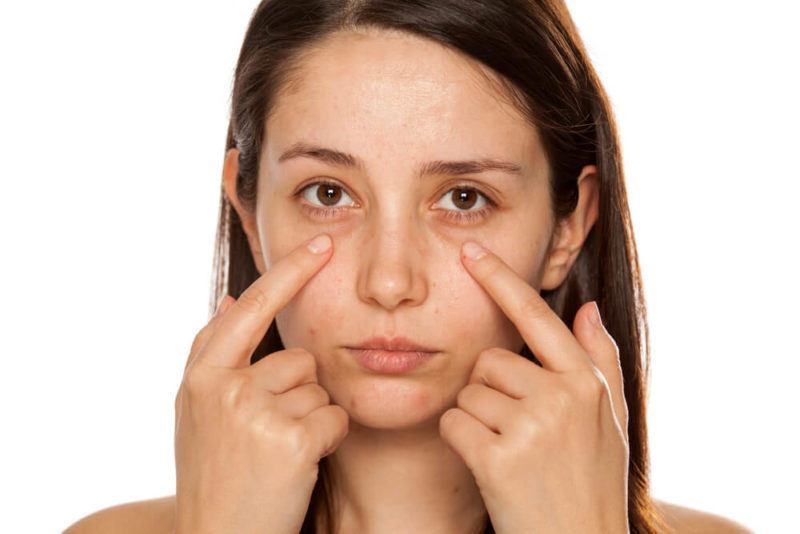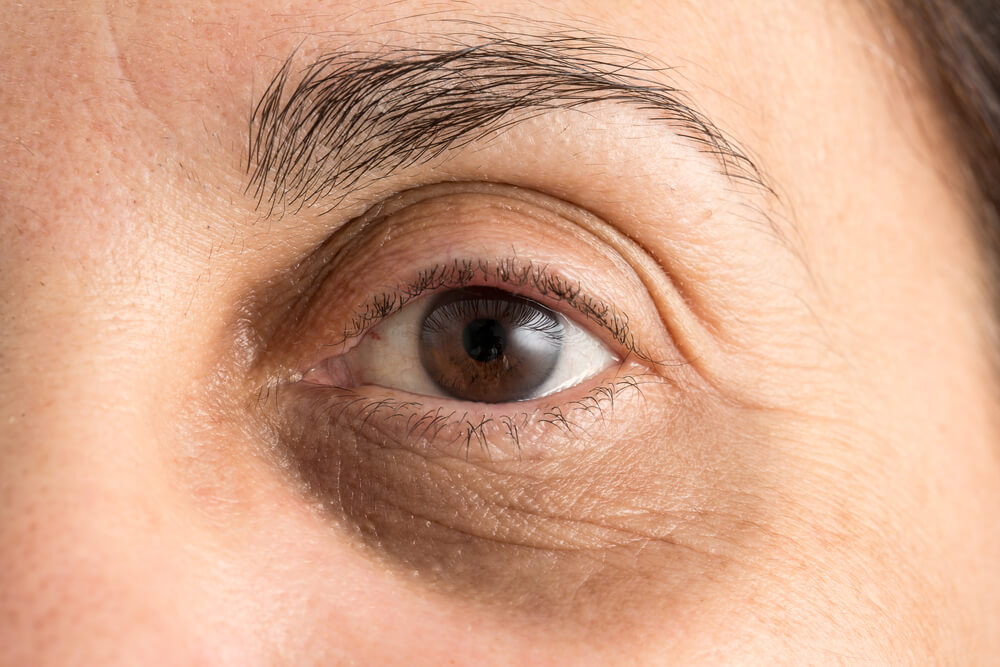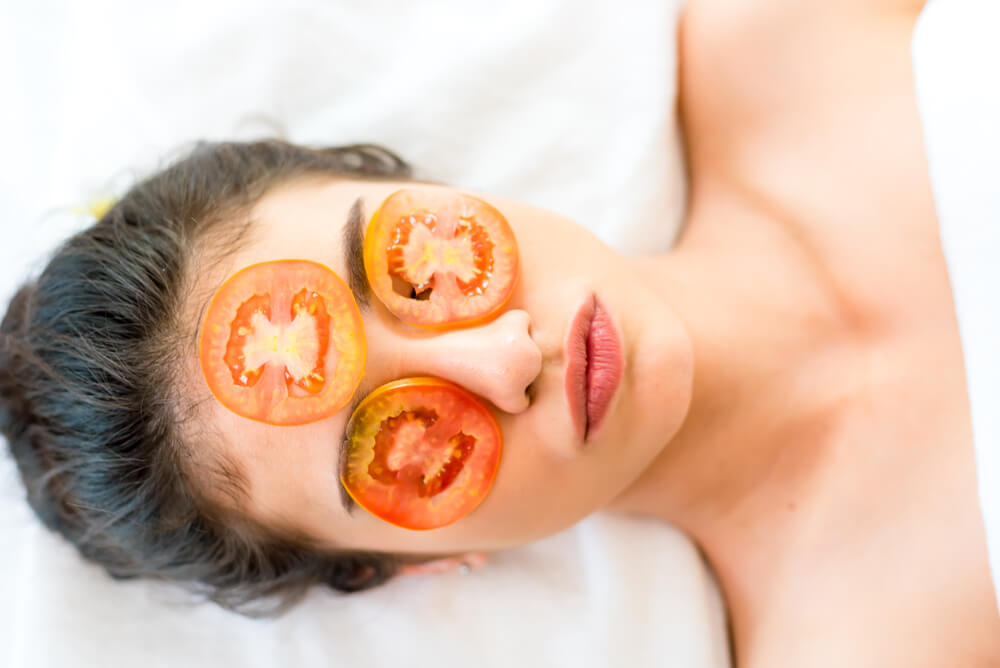
Under-eye bags, eye puffiness, and dark circles can make you look and feel older. As we age, essential nutrients that make your skin youthful-looking and springy, decline in production. These nutrients, known as collagen and elastin are the main components of tight, dewy skin. Over time your skin stops producing these types of vitamins, which results in the signs of premature aging such as fine lines, creases, crepe skin, sagging, dark circles, puffiness, and under-eye bags.
If your skin is dehydrated, the signs of aging will become even more obvious. One of the best ways to prevent the loss of youthful-looking skin is with daily hydration – both inside and out. Prioritizing your eyes during your everyday skincare routine is a great way to prevent the development of premature aging of the skin. Additionally, applying skincare products directly to the eye area, where your delicate skin is mostly dehydrated can contribute to younger-looking skin.
How Do Dark Circles Happen?
When your skin is dehydrated, your skin cells shrink down, making blood vessels more prominent, and thus dark circles appear. Under-eye dark circles can also be the result of excess fluid beneath the eye causing puffiness as one more contributory factor of dark circles. Other factors that influence puffy, dark bags under the eye include genetics, sleep habits, the aging process, diet, and alcohol consumption.
Drinking water is just one step in rehydrating dry skin. You will need to take more steps, including feeding your skin with these hydrating foods. Some of them also contain a diverse range of nutrients including circulation-boosting amino acids, antioxidants, and minerals known to make a difference in the appearance of your aging skin.
Top Eight Hydrating Foods for Youthful Skin
Add these eight best foods for youthful skin to your everyday menu for supple, dewy skin.
- Cucumbers. You may already be using cucumbers in your beauty regimen to eliminate puffiness. You can juice them, cut them into medallions or spears to scoop up dips and dressings, add them to salads and sandwiches, and you can use them to garnish your beverages. This water-dense vegetable is not only sweet and delicious, but it is also packed with silica – a nutrient known to boost collagen production. Cucumbers also offer your skin-strengthening sulfur, which provides vitamin K, for more supple blood vessels and other nutrients including vitamins A, C, E, and K.
- Watermelon. This sweet, red fruit deserves the name. Being over 90% water, watermelon is a great skin hydrator as it passes through your digestive tract. You see, by consuming water-dense foods you deliver vital hydration directly to your body in another way besides drinking fluids. This saturation through the digestive tract helps maintain your hydration, even during times when you cannot drink water. Watermelon also offers key amino acids including l-citrulline, known to widen capillaries under the eye to reduce dark circles. Additionally, watermelon offers protective antioxidants, including beta-carotene, lycopene, fiber, vitamin B1, B6, and C, magnesium, potassium. You can cut the watermelon into any kind of shape you desire including slices, balls, cubes, or juice smoothie for an ultra-satisfying beverage.
- Blueberries. These beloved little berries are well-known for their health benefits due to the number of antioxidants they provide. The unique type of antioxidants known as anthocyanins are compounds that are responsible for the blueberry’s dark deep blue/purple hue. Also, a good source of lutein, another potent antioxidant for eye health, blueberries help protect blood vessels and circulation in the delicate area under your eye. You can snack on blueberries by the handful, blend them into smoothies, or freeze them for a refreshing treat on top of your favorite salad, yogurt, or even ice cream. It’s up to you to use the plump little blueberry for these nutrients: quercetin, lutein, omega-3, anthocyanins, manganese, vitamin C and K.
- Tomatoes. In a similar way that antioxidants provide blueberries their color, an antioxidant offers the bright red tomato it’s pigment. The bright color of tomatoes indicates the power of their nutrient value. For example, lycopene is known to protect blood vessels and capillaries of your eye area. Eating all types of tomatoes will boost the circulation of the eye area, feed your body nourishing antioxidants and other nutrients such as lycopene, lutein, beta-carotene, quercetin, and vitamin C. However, because a good amount of the antioxidants provided by tomatoes are in the skin, adding grape and cherry tomatoes to your menu are recommended. You can add them to salads and pasta dishes, or just pop them in your mouth for an explosion of nourishing flavor.

- Celery. If you enjoy eating healthy foods such as hummus and yogurt dip, you may also like foods including carrots, cucumbers, and celery because they are ideal finger foods. Celery acts as a natural diuretic and is also a good source of sodium and potassium. The sodium provided by celery is also a way to promote the intake of other nutrients. Able to flush out excess water and other fluids from your body, celery is an ideal food for reducing eye puffiness. Satisfy your crunchy cravings with this water-dense and delicious veggie for nutrients including sodium, potassium, quercetin, magnesium, and fiber.
- Mulberries. The most age-defying antioxidants are found in mulberries. This berry is rich in protective anthocyanins, but it also provides resveratrol. The combination of these two potent cellular protectors makes mulberries a must-have in your menu. Use the berries to top summer salads, in juice smoothies, eat them by the handful, make trail mix, or turn them into a sweet, savory jam. It’s up to you to incorporate this superfood into your regimen to gain key nutrients of vitamins A, B1, B2, and C, protein, antioxidants such as anthocyanins and resveratrol.
- Bee Pollen. Your friendly neighborhood buzzer takes better care of you than you may think. Bee pollen is one of the most nutritious things you can eat. Besides making moisturizing, nutrient-rich honey, bees also produce pollen rich in antioxidants that support eye circulation in delicate capillaries. Also loaded with skin tightening nutrients of protein to renew elastin and collagen for springy skin. Add bee pollen to fruit smoothies, juices, and baked goods to get 18 vitamins, amino acids, fatty acids, and vital protein.
- Spirulina. This blue-green algae is your skin’s best friend. A nutrient-dense powder, spirulina is loaded with protein essential for skin tissue and also includes sulfur for even stronger skin. Start using 1/4 teaspoon daily in your edible skincare regimen by adding spirulina powder to juices, smoothies, and yogurts. The nutrient-dense algae offer vital protein, B vitamins, fatty acids, antioxidants, and calcium for beautiful skin at every age.
Using topical skincare products to reduce the visible signs of skin aging is a great idea. However, if you are not taking vitamins, minerals, antioxidants, and other essential nutrients, topical skincare products simply won’t work. You must take good care of your skin at every age so that it looks youthful throughout the aging process. As we age, it can be difficult to maintain a springy, dewy texture of the skin, so go ahead and eat these top foods for skincare. Do not forget to use top-quality topicals, and sunscreen too.
If you have eye issues contact our Manhattan, NY Eye Care Center for guidance and help.
Contact Us
If you have more questions about LASIK procedures, get in touch with us.
Related Blogs

Timing is Everything: When to Consider LASIK After Nursing for Optimal Results
Timing is everything when considering LASIK eye surgery after nursing, and understanding the optimal period for this procedure is vital for both mother and baby.

Cataract Surgery: Restoring Clarity and Confidence
Cataract surgery is a transformative procedure that offers a new lease on clear vision and renewed confidence. As cataracts cloud the eye’s lens, causing blurred

Intralase LASIK Explained: What to Expect Before, During, and After the Procedure
Intralase LASIK is a cutting-edge procedure that offers a safe, effective, and precise way to enhance vision compared to traditional LASIK methods. Understanding what to
